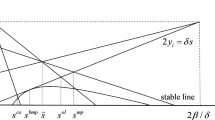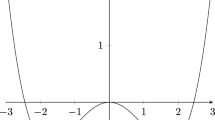Abstract
The literature that conducts numerical analysis of equilibrium in models with hyperbolic (quasi-geometric) discounting reports difficulties in achieving convergence. Surprisingly, numerical methods fail to converge even in a simple, deterministic optimal growth problem that has a well-behaved, smooth closed-form solution. We argue that the reason for nonconvergence is that the generalized Euler equation has a continuum of smooth solutions, each of which is characterized by a different integration constant. We propose two types of restrictions that can rule out the multiplicity: boundary conditions and shape restrictions on equilibrium policy functions. With these additional restrictions, the studied numerical methods deliver a unique smooth solution for both the deterministic and stochastic problems in a wide range of the model’s parameters.



Similar content being viewed by others
Notes
The related literature includes Laibson et al. [35], Barro [9], O’Donoghue and Rabin [55], Harris and Laibson [24], Angeletos et al. [3], Krusell and Smith [29–31], Krusell et al. [32], Luttmer and Mariotti [37], Maliar and Maliar [39–44], Judd [25], Sorger [61], Gong et al. [23], Chatterjee and Eyigungor [16], Balbus et al. [6, 7], Bernheim et al. [11], among others.
Other methods can be used in the context of models with quasi-geometric discounting. One of them is a “recursive optimization” approach suggested in Strotz [65], and Caplin and Leahy [14]. A possible implementation of this approach is found in the “pseudo-state space/enlarged state space” analysis of Kydland and Prescott [33] and Feng et al. [22]. Recently, in the context of the game theoretic approach, some literature have suggested turning the problem into a stochastic game (e.g., [24], Balbus et al. [6]). Also, in this latter tradition, one could also attempt to apply incentive-constrained dynamic programming methods [60], recursive dual approaches [49, 52, 56], and [17], or set-value dynamic programming methods proposed in Abreu, Pearce and Stachetti [1] (e.g., Balbus and Wozny [6]).
For the case of the standard geometric discounting, there is a general turnpike theorem that shows that an optimal program of a finite horizon economy asymptotically converges to an optimal program of the corresponding infinite horizon economy under very general assumptions; see Brock and Mirman [13], McKenzie [51], Joshi [26], Majumdar and Zilcha [38], Mitra and Nyarko [54], Becker [10], and Maliar et al. [47]. Turnpike theorems are also known for some dynamic games (see [28] for a survey), but they are not yet established for the economy with quasi-geometric discounting like ours.
Maliar and Maliar [40] shows another example of the model with quasi-geometric discounting that admits a closed-form solution under the assumption of the exponential utility function.
References
Abreu D, Pearce D, Stachetti E (1986) Optimal cartel equilibria with imperfect monitoring. J Econ Theory 39:251–269
Amann H (1976) Fixed point equations and nonlinear eigenvalue problems in ordered banach spaces. SIAM Rev 18(4):620–709
Angeletos M, Laibson D, Repetto A, Tobacman J, Weinberg S (2001) The hyperbolic consumption model: calibration, simulation, and empirical evaluation. J Econ Perspect 15(3):47–68
Arellano C, Maliar L, Maliar S, Tsyrennikov V (2014) Envelope condition method with an application to default risk models (Manuscript)
Aruoba SB, Fernández-Villaverde J, Rubio-Ramí rez J (2006) Comparing solution methods for dynamic equilibrium economies. J Econ Dyn Control 30:2477–2508
Balbus Ł, Reffet K, Woźny Ł (2015) Time consistent Markov policies in dynamic economies with quasi-hyperbolic consumers. Int J Game Theory 44(1):83–112
Balbus L, Reffet K, Wozny L (2012) Existence and uniqueness of time-consistent Markov policies for quasi-hyperbolic consumers under uncertainty (Manuscript)
Barillas F, Fernandez-Villaverde J (2007) A generalization of the endogenous grid method. J Econ Dyn Control 31(8):2698–2712
Barro R (1999) Ramsey meets Laibson in the neoclassical growth model. Q J Econ 114(4):1125–1152
Becker R (2012) Optimal growth with heterogeneous agents and the twisted turnpike: an example. Int J Econ Theory 8(1):24–47
Bernheim D, Ray D, Yeltekin S (2015) Poverty and self-control. Econometrica (forthcoming)
Bernheim D, Ray D (1986) On the existence of Markov-consistent plans under production uncertainty. Rev Econ Stud 53(5):877–882
Brock W, Mirman L (1972) Optimal economic growth and uncertainty: the discounted case. J Econ Theory 4:479–513
Caplin A, Leahy J (2006) The recursive approach to time inconsistency. J Econ Theory 131(1):134–156
Carroll K (2005) The method of endogenous grid points for solving dynamic stochastic optimal problems. Econ Lett 91:312–320
Chatterjee S, Eyigungor B (2014) Continuous Markov equilibria with quasi-geometric discounting. Working Papers 14–6, Federal Reserve Bank of Philadelphia
Cole H, Kubler F (2012) Recursive contracts, lotteries and weakly concave pareto sets. Rev Econ Dyn 15(4):479–500
Coleman W (1991) Equilibrium in a production economy with an income tax. Econometrica 59(4):1091–1104
Coleman W (2000) Uniqueness of an equilibrium in infinite-horizon economies subject to taxes and externalities. J Econ Theory 95(1):71–78
Datta M, Mirman L, Reffett K (2002) Existence and uniqueness of equilibrium in distorted dynamic economies with capital and labor. J Econ Theory 103(2):377–410
Fella G (2014) A generalized endogenous grid method for non-smooth and non-concave problems. Rev Econ Dyn 17(2):329–344
Feng Z, Miao J, Peralta-Alva A, Santos M (2014) Numerical simulation of nonoptimal dynamic equilibrium models. Int Econ Rev 55:83–110
Gong L, Smith W, Zou H (2011) Asset prices and hyperbolic discounting. CEMA Working Papers 486
Harris C, Laibson D (2001) Dynamic choices of hyperbolic consumers. Econometrica 69(4):935–959
Judd K (2004) Existence, uniqueness, and computational theory for time consistent equilibria: a hyperbolic discounting example (Manuscript)
Joshi S (1997) Turnpike theorems in nonconvex nonstationary environments. Int Econ Rev 38:245–248
Kocherlakota NR (1996) Reconsideration-proofness: a refinement for infinite horizon time inconsistency. Games Econ Behav 15(1):33–54
Kolokoltsov V, Yang W (2012) The turnpike theorems for Markov games. Dyn Games Appl 2(3):294–312
Krusell P, Smith A (2000) Consumption-savings decisions with quasi-geometric discounting. CEPR discussion paper no. 2651
Krusell P, Smith A (2003) Consumption-savings decisions with quasi-geometric discounting. Econometrica 71:365–375
Krusell P, Smith A (2008) Consumption-savings decisions with quasi-geometric discounting: the case with a discrete domain (Manuscript)
Krusell P, Kuruşçu B, Smith A (2002) Equilibrium welfare and government policy with quasi-geometric discounting. J Econ Theory 105(1):42–72
Kydland F, Prescott E (1980) Dynamic optimal taxation, rational expectations and optimal control. J Econ Dyn Control 2(1):79–91
Laibson D (1997) Golden eggs and hyperbolic discounting. Q J Econ 112(2):443–477
Laibson D, Repetto A, Tobacman J (1998) Self-control and saving for retirement. Brookings Pap Econ Act 1:91–172
Leininger W (1986) The existence of perfect equilibria in a model of growth with altruism between generations. Rev Econ Stud LIII:349–367
Luttmer E, Mariotti T (2003) Subjective discounting in an exchange economy. J Polit Econ 111(5):959–989
Majumdar M, Zilcha I (1987) Optimal growth in a stochastic environment: some sensitivity and turnpike results. J Econ Theory 43:116–133
Maliar L, Maliar S (2003) Solving the neoclassical growth model with quasi-geometric discounting: non-linear Euler-equation methods, IVIE WP AD 2003–23
Maliar L, Maliar S (2004) Quasi-geometric discounting: a closed-form solution under the exponential utility function. Bull Econ Res 56(2):201–206
Maliar L, Maliar S (2005) Solving the neoclassical growth model with quasi-geometric discounting: a grid-based Euler-equation method. Comput Econ 26:163–172
Maliar L, Maliar S (2006a) The neoclassical growth model with heterogeneous quasi-geometric consumers. J Money Credit Bank 38(3):635–654
Maliar L, Maliar S (2006b) Indeterminacy in a log-linearized neoclassical growth model with quasi-geometric discounting. Econ Model 23(3):492–505
Maliar L, Maliar S (2007) Short-run patience and wealth distribution. Stud Nonlinear Dyn Econ 11(1), Article 4
Maliar L, Maliar S (2013) Envelope condition method versus endogenous grid method for solving dynamic programming problems. Econ Lett 120:262–266
Maliar L, Maliar S (2014) Numerical methods for large scale dynamic economic models. In: Schmedders K, Judd K (eds) Handbook of computational economics, chapter 7, vol 3. Elsevier Science, Amsterdam
Maliar L, Maliar S, Taylor JB, Tsener I (2015) A tractable framework for analyzing a class of nonstationary Markov models. NBER 21155
Manuelli R, Sargent T (1987) Exercises in dynamic macroeconomic theory. Harvard University Press, Cambridge
Marcet A, Marimon R (1998) Recursive contracts, economics Working Papers, European University Institute
Maskin E, Tirole J (2001) Markov perfect equilibrium: I. Observable actions. J Econ Theory 100(2):191–219
McKenzie L (1976) Turnpike theory. Econometrica 44:841–865
Messner M, Pavoni N, Sleet C (2012) Recursive methods for incentive problems. Rev Econ Dyn 15(4):501–525
Mirman L, Morand O, Reffett K (2008) A qualitative approach to markovian equilibrium in infinite horizon economies with capital. J Econ Theory 139(1):75–98
Mitra T, Nyarko Y (1991) On the existence of optimal processes in nonstationary environments. J Econ 53:245–270
O’Donoghue T, Rabin M (1999) Doing it now or later. Am Econ Rev 89(1):103–124
Pavoni N, Sleet C, Messner M (2015) The dual approach to recursive optimization: theory and examples, 2014 meeting papers 1267, society for economic dynamics
Peleg B, Yaari M (1973) On the existence of a consistent course of action when tastes are changing. Rev Econ Stud 40(3):391–401
Phelps ES, Pollak RA (1968) On second-best national saving and game-equilibrium growth. Rev Econ Stud 35:185–199
Pollak RA (1968) Consistent planning. Rev Econ Stud 35:201–208
Rustichini A (1998) Dynamic programming solution of incentive constrained problems. J Econ Theory 78(2):329–354
Sorger G (2004) Consistent planning under quasi-geometric discounting. J Econ Theory 118(1):118–129
Santos M (1999) Numerical solution of dynamic economic models. In: Taylor J, Woodford M (eds) Handbook of macroeconomics. Elsevier Science, Amsterdam, pp 312–382
Stachurski J (2009) Economic dynamics: theory and computation. MIT Press, Cambridge
Stokey NL, Lucas RE Jr, Prescott E (1989) Recursive methods in economic dynamics. Harvard University Press, Cambridge
Strotz RH (1955–1956) Myopia and inconsistency in dynamic utility maximization. Rev Econ Stud 23:165–180
Tauchen G (1986) Finite state Markov chain approximations to univariate and vector autoregressions. Econ Lett 20:177–181
White M (2015) The method of endogenous gridpoints in theory and practice. Working Papers 15-03, University of Delaware
Acknowledgments
Lilia Maliar and Serguei Maliar acknowledge support from the Hoover Institution and Department of Economics at Stanford University, University of Alicante, Santa Clara University and MECD Grant ECO2012-36719. We thank the editors Edward Prescott and Kevin Reffett for many useful comments and suggestions.
Author information
Authors and Affiliations
Corresponding author
Rights and permissions
About this article
Cite this article
Maliar, L., Maliar, S. Ruling Out Multiplicity of Smooth Equilibria in Dynamic Games: A Hyperbolic Discounting Example. Dyn Games Appl 6, 243–261 (2016). https://doi.org/10.1007/s13235-015-0177-8
Published:
Issue Date:
DOI: https://doi.org/10.1007/s13235-015-0177-8
Keywords
- Hyperbolic discounting
- Quasi-geometric discounting
- Time inconsistency
- Markov perfect equilibrium
- Markov games
- Turnpike theorem
- Neoclassical growth model
- Endogenous gridpoints
- Envelope condition




